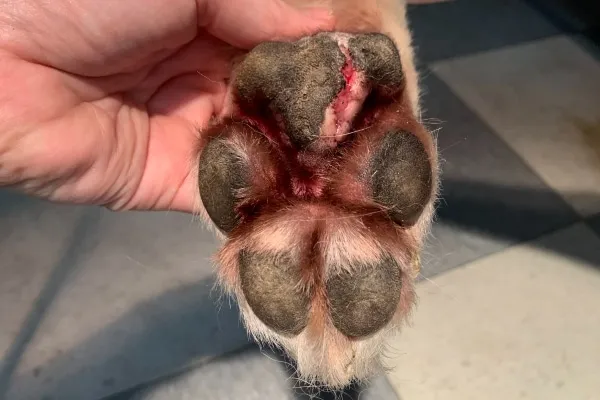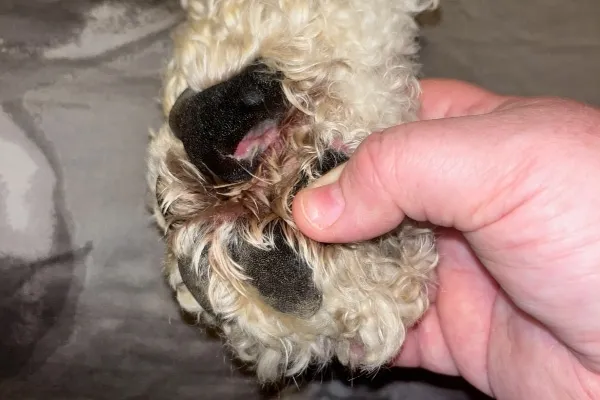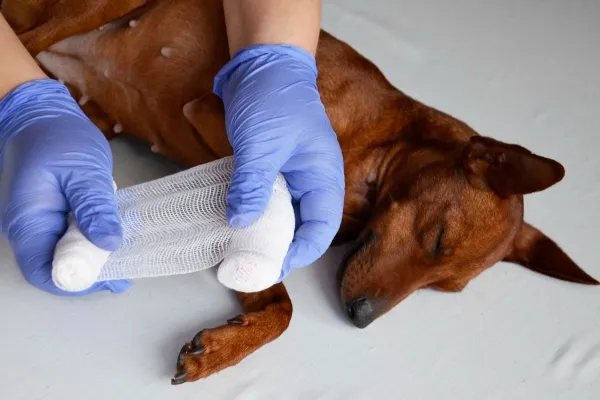A dog’s paw pad injury can range from minor scrapes to significant burns, cuts, or punctures. Knowing How To Heal A Dog's Torn Foot Pad effectively is crucial for any pet parent. As an integrative veterinarian, I often see dogs with various paw ailments. Recently, a client brought her Labrador Retriever, April, to me for a paw pad injury. April started limping during her daily walk, and her mom quickly discovered she had stepped on a sliver of broken glass. Thankfully, April’s mom had prior “doggie first aid” training. She carefully removed the glass, cleaned, and bandaged the paw before scheduling an appointment. When I examined April, I commended her mom on her excellent first aid. The paw looked great, and the bandaging was superb.
Not every dog parent has had the benefit of such training, which is why I’ve prepared this guide. It will help you recognize, provide first aid for, and understand the veterinary approach to treating paw pad injuries, especially those involving tears or significant damage. But first, let’s understand why these resilient pads are so vital.
The Vital Role of Your Dog’s Paw Pads
We often hear the phrase “put your best foot forward,” typically referring to approaching a new challenge with a positive attitude. For our canine companions, literally putting their best foot forward is equally important. Your dog’s paws play a significant role in their overall well-being. The intricate network of muscles, bones, tendons, and ligaments allows your dog to walk, run, and play comfortably and securely, largely thanks to their remarkable paw pads.
These thick, pliable foot pads provide essential cushioning, absorbing impact with every step your dog takes. This vital function reduces strain on the bones and joints of their feet. In addition, combined with their toenails, paw pads offer traction, helping your dog navigate various terrains, including rough surfaces. Finally, and crucially, they provide a layer of protection against extreme temperatures.
For a deeper dive into the fascinating structure of your dog’s paws, you can explore more about dog paw anatomy.
Common Types of Paw Pad Injuries in Dogs
Given their constant contact with the ground, paw pads are perpetually exposed to elements that can cause wear and tear. This makes them susceptible to a wide array of injuries, many of which can lead to a “torn” appearance or significant damage.
Foreign Bodies
One of the most frequent foot injuries I encounter is a foreign object piercing the paw pad. Sharp items such as broken glass, splinters, nails, sticks, and even foxtails in dogs can become embedded, causing a painful puncture wound that may tear the surrounding tissue.
Cuts and Lacerations
If a sharp object doesn’t become lodged, it might instead cause a cut or laceration. These are common paw pad injuries because the pads act as a protective barrier for the rest of the foot. Dogs can easily slice their pads on sharp debris. Additionally, non-traumatic cuts can occur when dry paw pads crack and split open, especially during extreme weather conditions. Learning how to treat a cut on a dog’s leg shares similar principles for paw pad cuts.
 A close-up image of a dog's paw pad showing a deep cut
A close-up image of a dog's paw pad showing a deep cut
Paw Pad Flaps
Paw pad flaps are similar to cuts but typically cover a larger surface area, running roughly parallel to the pad’s surface. These usually occur when something slices the dog’s foot horizontally, partially shaving off a section of the paw pad. For example, entanglement in sharp wire or metal can create a loose flap of skin. Flaps can also develop if a deep cut is left untreated and the tissue eventually tears, forming a loose piece. Generally, flaps are more painful than simple cuts because each step pulls on the loose skin, causing irritation. Effectively addressing a flap is key to knowing how to heal a dog’s torn foot pad.
Burns
Unfortunately, paw pad burns are also prevalent, especially during summer. Hot asphalt, concrete, or artificial turf can reach blistering temperatures. Even on an 86°F day, pavement can exceed 135°F, causing thermal burns when your dog walks on hot pavement. Conversely, prolonged exposure to extremely cold temperatures, like ice, can also cause burns. Ice melt products used in winter can dry, crack, or burn paws. Chemical burns can result from walking through spilled caustic substances, and abrasive surfaces like tennis courts can cause friction burns. For related issues, understanding how to treat a bruised dog paw might also be helpful.
Ingrown Toenails
Overly long nails can curl and penetrate the paw pad, creating a painful wound. Beyond the immediate pain, ingrown toenails can lead to a paw pad infection by trapping dirt and bacteria. This highlights the importance of regular nail trims. I stress the significance of trimming your dog’s toenails monthly. If you’re uncomfortable doing it yourself, my Nail Trimming Master Course can help, or consult your veterinarian.
Recognizing the Signs of a Torn or Injured Paw Pad
If your dog suffers any of the paw pad injuries discussed, you might notice several distinct symptoms:
- Sudden lameness: Your dog is limping or unwilling to put weight on the affected paw.
- Crying out: Pain response when attempting to put pressure on the paw.
- Bleeding: Visible blood from the paw pad.
- Licking or biting: Excessive attention to the paw.
- Swelling: The foot appears enlarged.
- Discoloration or reddening: The paw pad may look inflamed.
- Visible injury: A cut, flap, puncture, or foreign object may be clearly seen.
- Discoloration of hair: Staining around the paw, possibly from blood or discharge.
 A dog looking at its paw, which could be indicative of an injury, showing concern or discomfort
A dog looking at its paw, which could be indicative of an injury, showing concern or discomfort
Should you observe any of these symptoms, carefully inspect your dog’s paw. Depending on your findings, you may be able to administer initial first aid before seeking veterinary care. This is a critical first step in knowing how to heal a dog’s torn foot pad.
Immediate First Aid for a Dog’s Torn Foot Pad
To best address your dog’s paw pad injury, follow these step-by-step first aid instructions. Remember, the goal is to stabilize the injury and prevent further harm until professional veterinary care can be sought, if necessary. Many of these steps are universally applicable to how to treat a dog paw injury in general.
1. Assess Your Dog’s Overall Condition
First, comfort your dog and evaluate their demeanor. If your dog is in severe pain, it might not be safe to examine their foot alone. Even the most gentle and well-behaved dogs can react defensively when experiencing intense pain. If your dog resists any attempt to touch the injured paw, prioritize seeking immediate veterinary care rather than proceeding with the following steps. Their safety, and yours, comes first.
2. Detailed Paw Examination
If you can safely examine your dog’s paw, meticulously inspect the top and bottom, the paw pads themselves, and the areas between the toes. It’s crucial to identify the specific type of injury: is it a cut, a flap (indicating a torn pad), a puncture wound, a burn, or perhaps a dog ripped a nail off? Different injuries may require slightly varied first aid approaches. For a split pad, these steps are similar to how to heal a dog’s split pad.
If a foreign object is present, proceed to step 3a. Otherwise, continue to step 3b for a bleeding wound or step 4 for burns or non-bleeding wounds.
3. Removing Foreign Objects (if safe) & Stopping Bleeding
3a. Foreign Objects: If your dog has a small, superficial object puncturing the paw pad, you might be able to remove it gently with your fingers or tweezers. However, if the object is deeply embedded, or if you suspect it might have punctured a blood vessel, nerve, or joint, do not attempt to remove it yourself. Instead, make an emergency vet visit immediately. Removing it improperly could cause more damage or severe bleeding.
3b. Stopping Bleeding: For actively bleeding wounds, apply firm, even pressure with a clean cloth or paper towel. Minor wounds should stop bleeding within one to two minutes. If the cut continues to bleed steadily for 10 to 15 minutes, contact your veterinarian immediately, as this could indicate a more serious emergency.
4. Cleaning the Wound Thoroughly
Once the bleeding has ceased, thoroughly clean the wound. I recommend using cool water, which helps reduce swelling and alleviate pain, especially for burns. You can also use a gentle antibacterial soap or disinfecting agents like chlorhexidine or betadine to help remove bacteria and prevent infection. Be aware that the wound might start bleeding slightly again during cleaning; if this happens, gently reapply pressure until it stops.
5. Applying a Protective Bandage
To keep the wound clean and protected from further injury, you will likely need to bandage your dog’s foot. If you lack proper bandaging materials, wrapping a clean towel or T-shirt around a bleeding wound can serve as a temporary measure while you head to the vet. When applying a bandage, always use clean materials such as sterile gauze pads and vet wrap. For comprehensive instructions on proper technique, please refer to my article on how to wrap a dog’s paw.
 A person's hands carefully bandaging a dog's paw
A person's hands carefully bandaging a dog's paw
A bandage that is too tight is more detrimental than no bandage at all. Ensure you can easily insert one to two fingers into the top of the bandage; if not, it’s likely too tight. Monitor for signs that the bandage is impeding circulation, such as swollen toes (if they are exposed), a foot that is cool to the touch, or discoloration.
6. When to Contact Your Veterinarian
Even after providing first aid, it is crucial to follow up with your veterinarian to determine if additional steps are necessary for how to heal a dog's torn foot pad. While awaiting your veterinary appointment, inspect and change the bandage daily. This allows you to monitor the wound for any changes, signs of infection, or ensuring the bandage isn’t too tight.
Veterinary Assessment and Treatment for Paw Pad Injuries
During your appointment, your veterinarian will begin with a comprehensive physical exam. While the primary concern is the paw pad injury, a full-body assessment ensures no other injuries are present. The vet will then meticulously examine the affected foot, checking for cuts, punctures, burns, or other forms of trauma. They will also palpate and manipulate the bones and joints to rule out any underlying structural issues.
If your vet suspects a foreign object (like a foxtail or a metal nail) is deeply embedded in the foot, they may recommend an X-ray. This imaging can help determine if the wound involves bones or joints and precisely locate the foreign body, especially if it’s metallic.
Your vet may also trim the hair around the injured paw to allow for better visualization and to keep the wound clean. After this, the wound will be thoroughly cleaned, and any debris or foreign objects will be carefully removed.
 A veterinarian's hands gently examining a dog's paw, potentially trimming hair to assess an injury
A veterinarian's hands gently examining a dog's paw, potentially trimming hair to assess an injury
Why Stitches Aren’t Always Used for Paw Pad Tears
You might find it surprising that your veterinarian will probably not suture a torn paw pad closed. Unlike other areas of a dog’s body, paw pads do not hold stitches well. Due to constant friction and movement, sutures can easily tear out. In many cases, suturing the pad doesn’t significantly speed up the healing process.
However, bandaging the foot is incredibly beneficial. For cuts, tears, or burns, your veterinarian may apply an antibacterial ointment or a soothing cream to promote healing and reduce pain. A multi-purpose bandage will then be applied to:
- Control any remaining bleeding.
- Decrease the chances of re-injury.
- Keep the wound clean.
- Contain any applied medication.
- Prevent your dog from licking or chewing on the wound (though an Elizabethan collar, or E-collar, might also be necessary).
Pay close attention to your veterinarian’s instructions regarding bandage changes, recommended materials, and any necessary recheck appointments.
Patience and Communication are Key
As your vet will likely explain, paw pad injuries can take considerable time to heal because your dog is constantly using their feet. Be patient with the process, diligently follow your vet’s instructions, and do not hesitate to contact them if you suspect the injury isn’t healing well. Remember, foot and toe swelling from an overly tight bandage is one of the most common complications I observe with paw pad injuries, so regular monitoring is essential for how to heal a dog's torn foot pad successfully.
How to Prevent Future Paw Pad Injuries
While some injuries are unavoidable, there are several precautions you can take to minimize the risk of future paw pad trauma:
- Avoid extreme temperatures: Time your walks to avoid the hottest parts of the day, which also helps prevent heat stroke in dogs. Always test pavement with the back of your hand; if you can’t comfortably hold it for 7-10 seconds, it’s too hot for your dog’s paws. Similarly, protect paws from prolonged exposure to ice or snow.
- Consider protective dog booties: Products like PawZ dog boots are thin enough to allow natural ground feel while offering protection against ice melt chemicals or extreme temperatures. They can also keep bandages clean and dry outdoors. (Important: remove PawZ boots once indoors to prevent circulation issues.)
- Clean paws after walks: Wash your dog’s feet after winter walks to remove ice melt products or any other chemicals they might have encountered.
- Use thicker dog boots for hazardous terrain: If walking in areas with sharp rocks, glass, or debris, thicker dog boots or socks can provide added protection. Be aware that some boots can affect a dog’s proprioception in dogs, making them less aware of their foot placement.
- Inspect thoroughly after outdoor excursions: If you live in or visit areas prone to foxtails or other plant awns, carefully inspect your dog’s entire body, especially their paws, after every outdoor trip.
- Regular nail trims: Keep your dog’s nails trimmed regularly to prevent them from growing long enough to curl into the paw pad. Learning how to clip dog nails properly is essential.
- Be vigilant: Always keep an eye out for potential hazards on your walking paths or trails.
 A dog wearing protective booties while walking in the snow, illustrating paw protection
A dog wearing protective booties while walking in the snow, illustrating paw protection
You Can Provide Paw Pad Injury First Aid for Your Dog
While prevention is key, being prepared for potential injuries is equally important. If you don’t already have a dog first aid kit, now is the perfect time to assemble one for your home and another for your car or backpack. You never know when you might need it!
Hopefully, your dog will never experience a paw pad injury. But if they do, remember to stay calm, grab your first aid kit, and follow the steps outlined in this article. I believe that you are capable of providing effective first aid to your dog. However, when in doubt, always contact your veterinarian for expert advice. With prompt and appropriate care, your pup can be back to playing in no time!
Has your dog ever had a paw pad injury?
Please share your experiences and insights in the comments below.
References
- The Kennel Club. (n.d.). Hot pavements. Retrieved from https://www.thekennelclub.org.uk/health-and-dog-care/health/health-and-care/a-z-of-health-and-care-issues/hot-pavements/
